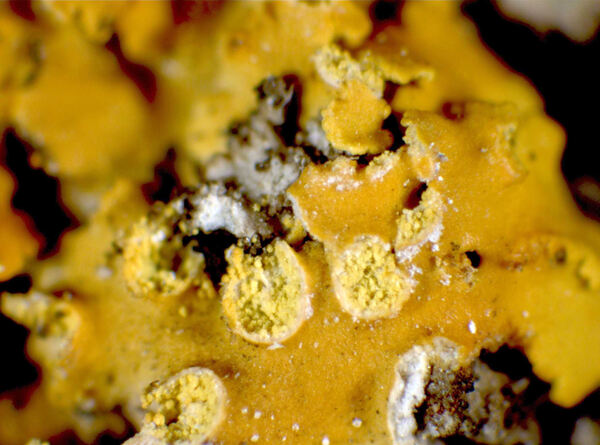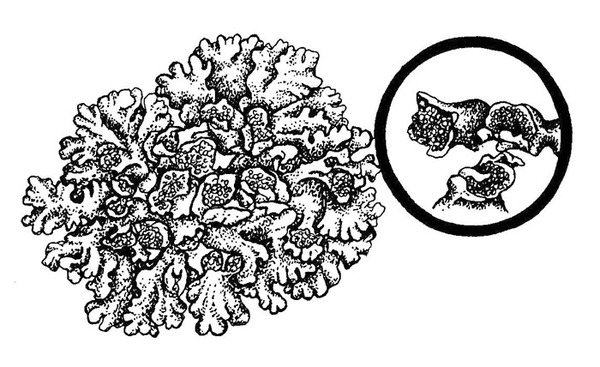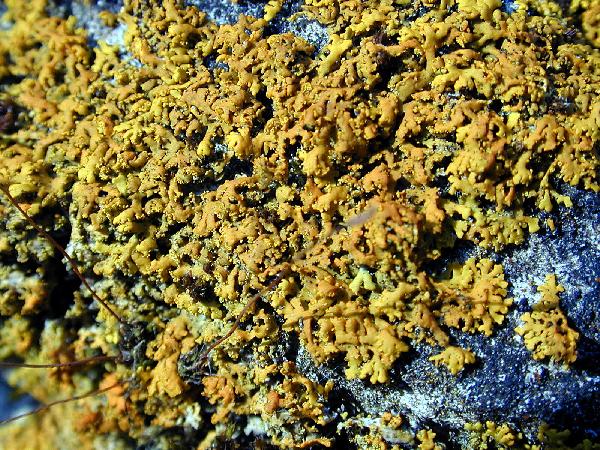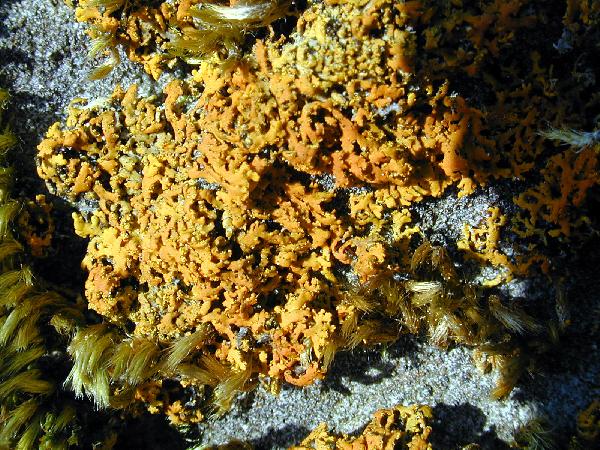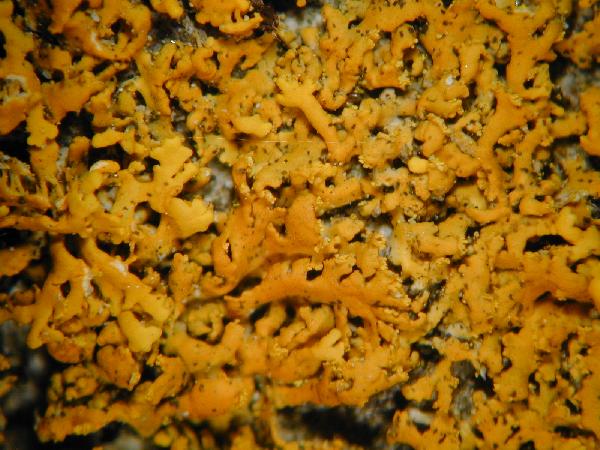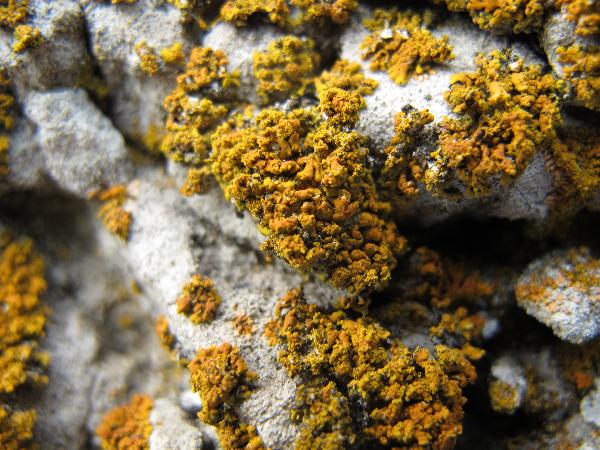Xanthomendoza fallax (Hepp) Søchting, Kärnefelt & S.Y. Kondr.
Mitt. Inst. allg. Bot. Hamburg, 30-32: 237, 2002.. Basionym: Placodium fallax Hepp - Flecht. Eur., XI. no. 633. 1860.
Synonyms: Lecanora candelaria var. substellaris Ach.; Oxneria huculica S.Y. Kondr.; Physcia controversa auct. ital. p.p. ; Physcia fallax Hepp ex Arnold nom. illegit. ; Xanthomendoza huculica (S.Y. Kondr.) Diederich; Xanthoria fallax Hepp ex Arnold; Xanthoria substellaris (Ach.) Vain.
Distribution: N - VG (Castello 1996), Frl (Badin & Nimis 1996, Castello & Skert 2005, Tretiach & Molaro 2007), Ven (Nimis & al. 1996c, Caniglia & al. 1999, Lazzarin 2000, Nascimbene 2005c, 2008), TAA (Zieger & al. 2003, Obermayer 2003, Nascimbene 2005b, 2006c, 2014, Nascimbene & al. 2007b, 2014, 2022, Cristofolini & al. 2008, Zarabska & al. 2009, Brackel 2013, Nimis & al. 2015), Lomb (Rivellini 1994, Arosio & Rinaldi 1995, Valcuvia & Brusoni 1996, Brusoni & al. 1997, Zocchi & al. 1997, Roella 1999, Brusoni & Valcuvia 2000, Casarini & al. 2000, Arosio & al. 2000, 2003, Furlanetto 2010, Brackel 2013, Gheza & al. 2015, 2020, Gheza 2019), Piem (Caniglia & al. 1992, Piervittori & al. 1996b, Arosio & al. 1998, Piervittori 1998, 2003, Clerc & al. 1999, Isocrono & Falletti 1999, Griselli & al. 2000, 2003, Castino 2004, Isocrono & al. 2004, 2005b, 2007, Isocrono & Piervittori 2008, Furlanetto 2010, Matteucci & al. 2010), VA (Piervittori & Maffei 1996, 2001, Piervittori & Isocrono 1999, Valcuvia & al. 2000b, Piervittori & al. 2001, Matteucci & al. 2008, 2008c, Isocrono & al. 2008, Ongaro & al. 2022), Emil (Bassi 1995, Gasparo & Tretiach 1996, Marconi & al. 2006, Morselli & Regazzi 2006, Cioffi 2009, Fariselli & al. 2020), Lig (Giordani & Incerti 2008). C - Tosc, Marc (Frati & Brunialti 2006), Abr (Olivieri & al. 1997, 1997b, Loppi & al. 1999), Sar (Rizzi & al. 2011, Di Nuzzo & al. 2022).
Description: Thallus foliose, heteromerous, dorsiventral, orange to orange-yellow, adnate to loosely adnate, lobed, forming regular to irregular, 1-2(-3) cm wide rosettes which often coalesce to cover much larger surfaces. Lobes flattened, 2.5-5(-7) mm long, 0.7-2(-3) mm wide, smooth, at first with helmet-shaped soralia at the apex of short, inner, appressed lobes, formed between the upper and lower cortices, soon becoming crescent-shaped to almost crater-like, the soredia yellow, contrasting with the orange thallus colour. Lower surface white to yellow, somewhat wrinkled, with many short, white rhizines. Upper and lower cortex paraplectenchymatous; medulla white. Apothecia lecanorine, very rare, 0.5-0.7 mm across, laminal, stipitate, the margin initially smooth but often becoming sorediate. Thalline exciple paraplectenchymatous; proper exciple a strongly gelatined plectenchyma with unoriented, short-celled hyphae; epithecium orange-brown, K+ purple-red; hymenium colourless; paraphyses simple or sparingly branched; hypothecium colourless. Asci 8-spored, clavate, functionally unitunicate, apically thickened with a broad internal beak, the inner part of apex and external cap I+ blue, Teloschistes-type. Ascospores 2-celled, polarilocular, hyaline, ellipsoid, (10.5-)12-16 x (5-)6-7(-8) µm, the equatorial thickening (“septum”) 3-5(-6) µm. Pycnidia common, immersed to projecting, darker orange than thallus. Conidia short-bacilliform. Spot tests: thallus and soredia K+ purple-red, C-, KC-, P-, UV+ orange. Chemistry: parietin (major), fallacinal (major), emodin, teloschistin (major) and parietinic acid (chemosyndrome A3 of Søchting 1997).Note: mostly on tree bark, in well-lit, eutrophicated situations, often abundant on the bases of wayside trees along roads frequently treated with salt in winter; most frequent in areas with a subcontinental climate, such as in the dry alpine valleys . Pending molecular analysis of original material of X. huculica, here I follow Lindblom (2019) in considering the latter species as a synonym of X. fallax. Earlier records from Southern Italy (see Nimis 1995, 2016) may be due to confusion with X. fulva, and are not accepted here.
Growth form: Foliose, narrow lobed
Substrata: bark
Photobiont: green algae other than Trentepohlia
Reproductive strategy: mainly asexual, by soredia, or soredia-like structures (e.g. blastidia)
Subcontinental: restricted to areas with a dry-subcontinental climate (e.g. dry Alpine valleys, parts of Mediterranean Italy)
Commonnes-rarity: (info)
Alpine belt: absent
Subalpine belt: absent
Oromediterranean belt: absent
Montane belt: rather rare
Submediterranean belt: very rare
Padanian area: absent
Humid submediterranean belt: extremely rare
Humid mediterranean belt: absent
Dry mediterranean belt: absent

Predictive model
Herbarium samples
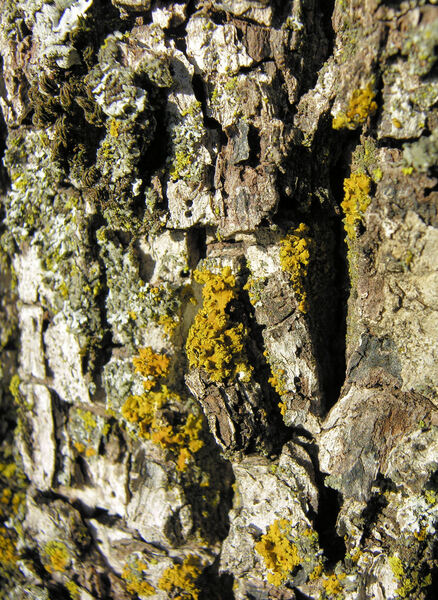

Andrea Moro; Owner: Department of Life Sciences, University of Trieste
Slovenia, Lipica/Lipizza; altitude: 2
2008.02.21
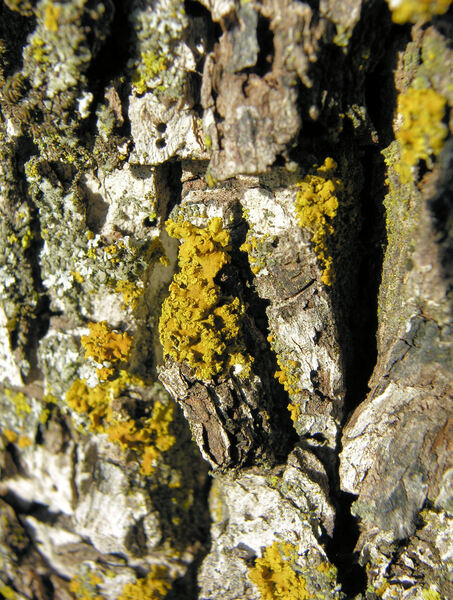

Andrea Moro; Owner: Department of Life Sciences, University of Trieste
Slovenia, Lipica/Lipizza; altitude: 2
2008.02.21
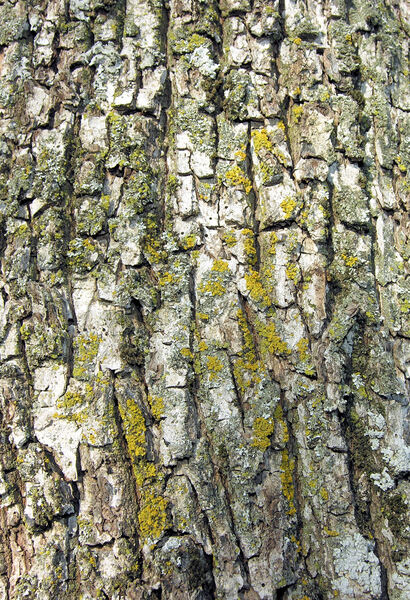

Andrea Moro; Owner: Department of Life Sciences, University of Trieste
Slovenia, Lipica/Lipizza; altitude: 2
2008.02.21


Juri Nascimbene; Owner: Department of Life Sciences, University of Trieste
Italy, Trentino-Alto Adige, Trento, Villa Welsperg, Centro Visitatori del Parco di Paneveggio; altitude: 1030 m
03.04.2009
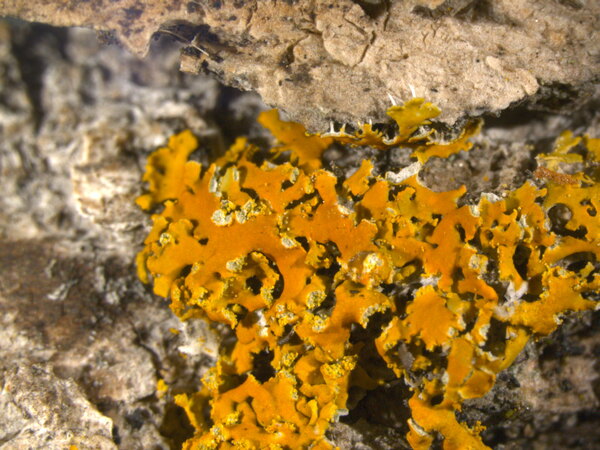

Juri Nascimbene; Owner: Department of Life Sciences, University of Trieste
Italy, Trentino-Alto Adige, Trento, Villa Welsperg, Centro Visitatori del Parco di Paneveggio; altitude: 1030 m
03.04.2009
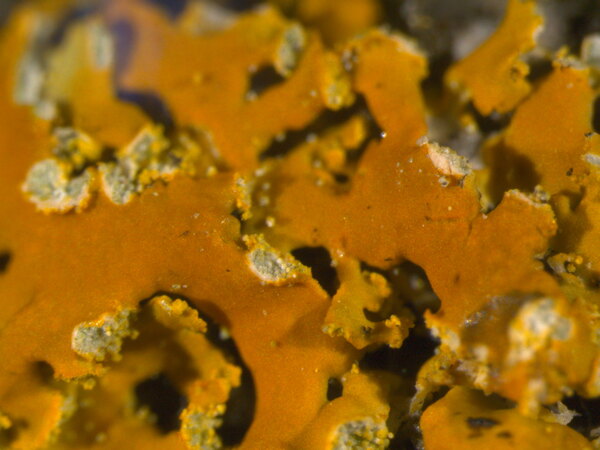

Juri Nascimbene; Owner: Department of Life Sciences, University of Trieste
Italy, Trentino-Alto Adige, Trento, Villa Welsperg, Centro Visitatori del Parco di Paneveggio; altitude: 1030 m
03.04.2009


P.L. Nimis; Owner: Department of Life Sciences, University of Trieste
Italy, Friuli Venezia Giulia, Trieste, Trieste Karst, Rocca di Monrupino (Rupingrande)
07.07.2016
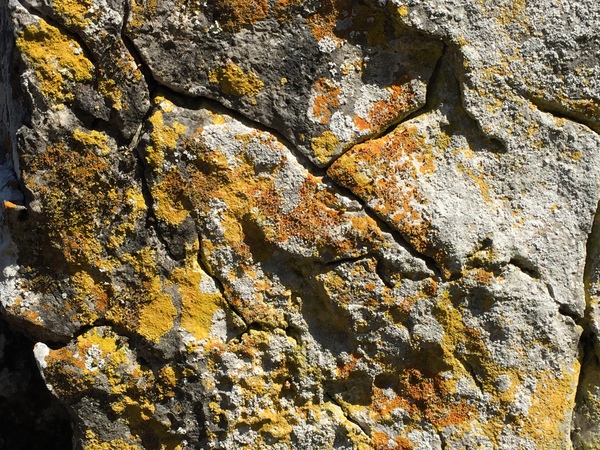

P.L. Nimis; Owner: Department of Life Sciences, University of Trieste
Italy, Friuli Venezia Giulia, Trieste, Trieste Karst, Rocca di Monrupino (Rupingrande)
07.07.2016
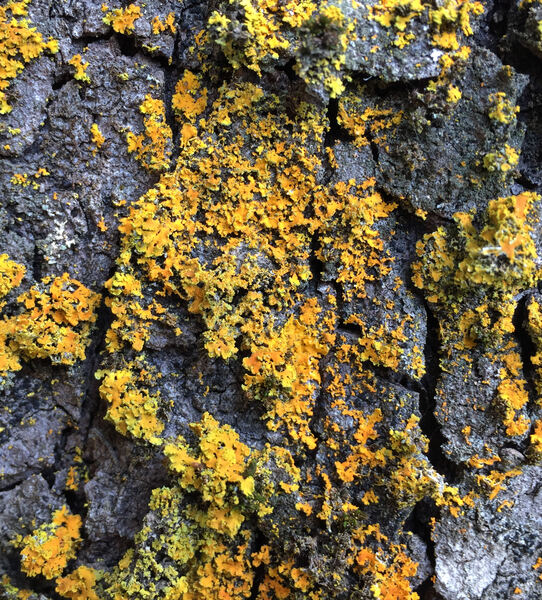

P.L. Nimis; Owner: Department of Life Sciences, University of Trieste
Italy, Friuli Venezia Giulia, Udine, Ampezzo Carnico, 650 m
09.09.2016
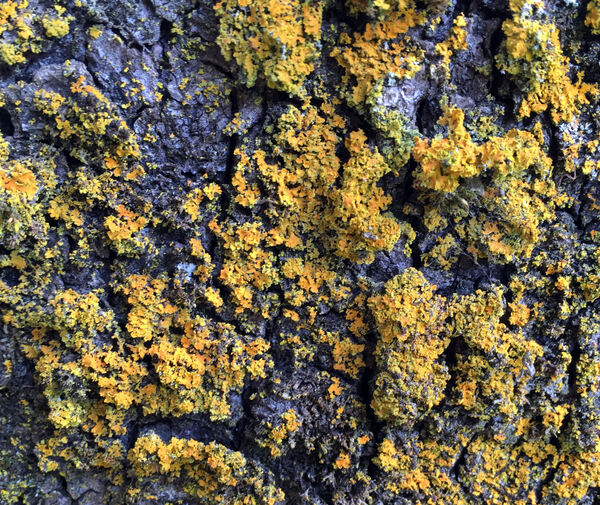

P.L. Nimis; Owner: Department of Life Sciences, University of Trieste
Italy, Friuli Venezia Giulia, Udine, Ampezzo Carnico, 650 m
09.09.2016
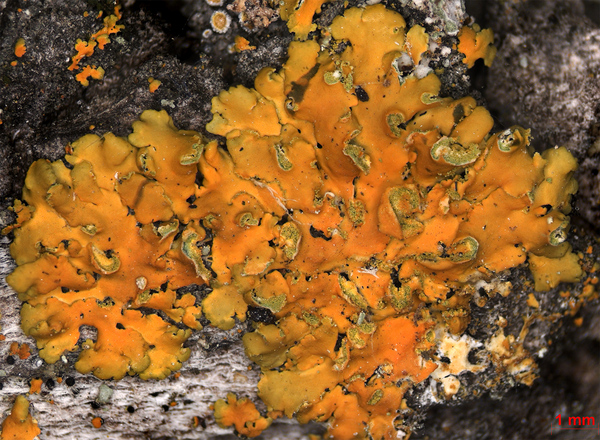
Walter Obermayer CC BY-SA 4.0 - Source: Lichens of Noricum - http://lichens-of-noricum.uni-graz.at/
as X. huculica
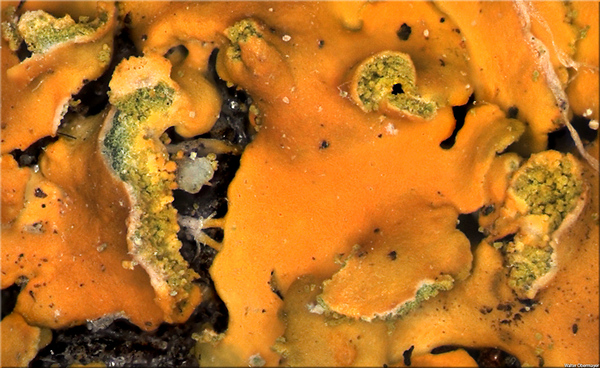
Walter Obermayer CC BY-SA 4.0 - Source: Lichens of Noricum - http://lichens-of-noricum.uni-graz.at/
as X. huculica
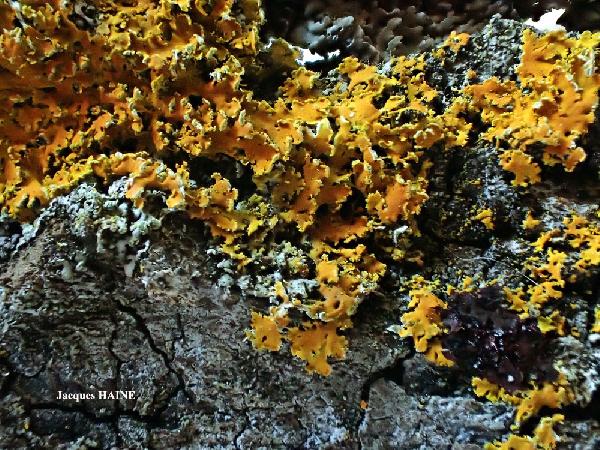
Jacques Haine - Source: http://www.lichensmaritimes.org/index.php?task=fiche&lichen=1040&lang=en
France, Drôme
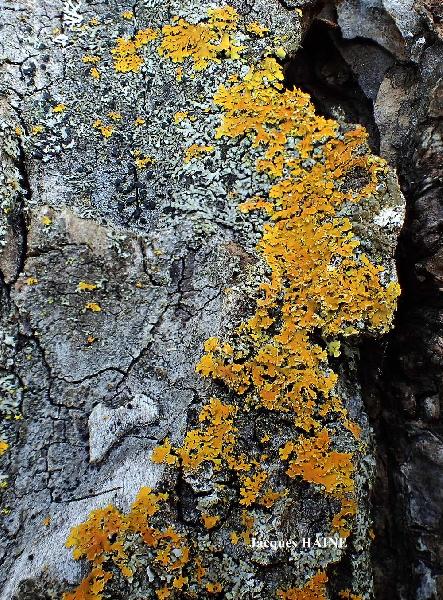
Jacques Haine - Source: http://www.lichensmaritimes.org/index.php?task=fiche&lichen=1040&lang=en
France, Drôme
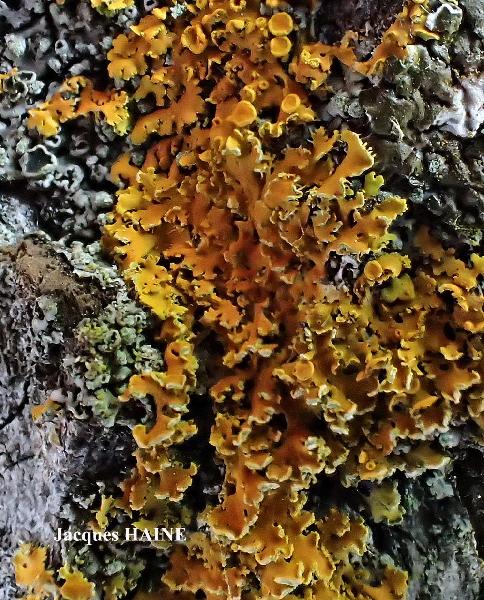
Jacques Haine - Source: http://www.lichensmaritimes.org/index.php?task=fiche&lichen=1040&lang=en
France, Drôme
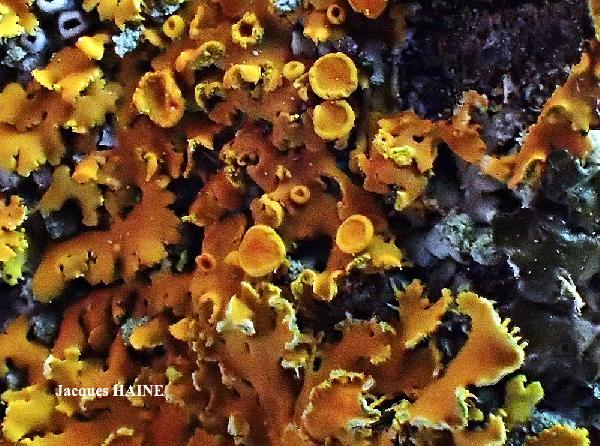
Jacques Haine - Source: http://www.lichensmaritimes.org/index.php?task=fiche&lichen=1040&lang=en
France, Drôme

Jacques Haine - Source: http://www.lichensmaritimes.org/index.php?task=fiche&lichen=1040&lang=en
France, Drôme
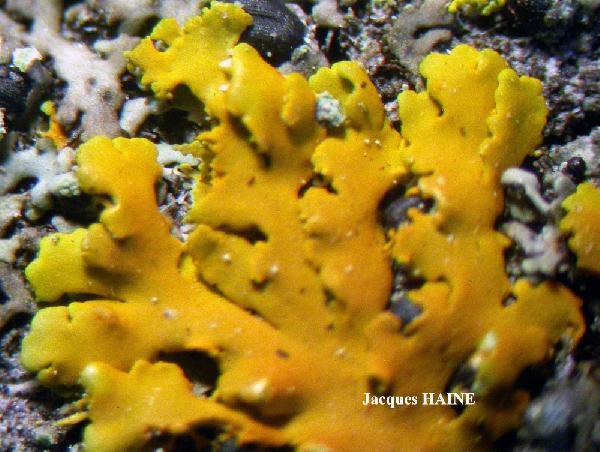
Jacques Haine - Source: http://www.lichensmaritimes.org/index.php?task=fiche&lichen=1040&lang=en
France, Drôme

Jacques Haine - Source: http://www.lichensmaritimes.org/index.php?task=fiche&lichen=1040&lang=en
France, Drôme
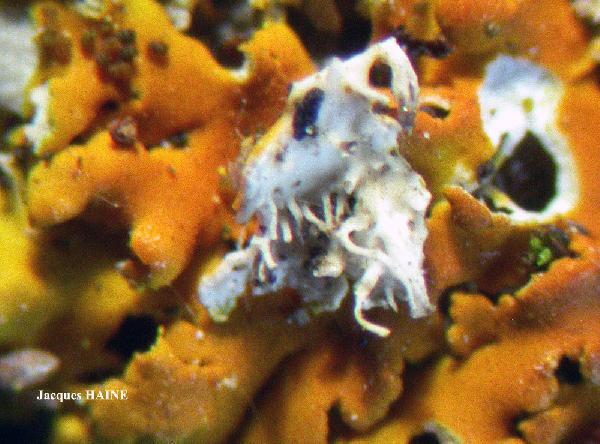
Jacques Haine - Source: http://www.lichensmaritimes.org/index.php?task=fiche&lichen=1040&lang=en
France, Drôme

Jacques Haine - Source: http://www.lichensmaritimes.org/index.php?task=fiche&lichen=1040&lang=en
France, Drôme

Jacques Haine - Source: http://www.lichensmaritimes.org/index.php?task=fiche&lichen=1040&lang=en
France, Drôme
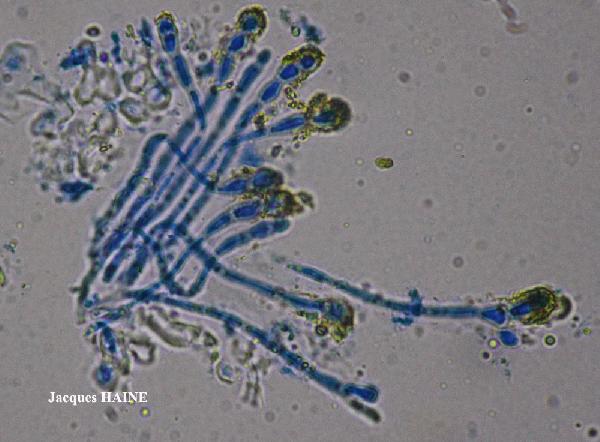
Jacques Haine - Source: http://www.lichensmaritimes.org/index.php?task=fiche&lichen=1040&lang=en
France, Drôme
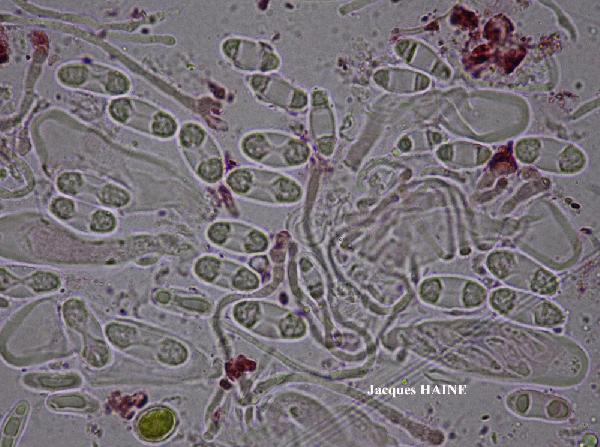
Jacques Haine - Source: http://www.lichensmaritimes.org/index.php?task=fiche&lichen=1040&lang=en
France, Drôme
Growth form: Foliose, narrow lobed
Substrata: bark
Photobiont: green algae other than Trentepohlia
Reproductive strategy: mainly asexual, by soredia, or soredia-like structures (e.g. blastidia)
Subcontinental: restricted to areas with a dry-subcontinental climate (e.g. dry Alpine valleys, parts of Mediterranean Italy)
Commonnes-rarity: (info)
Alpine belt: absent
Subalpine belt: absent
Oromediterranean belt: absent
Montane belt: rather rare
Submediterranean belt: very rare
Padanian area: absent
Humid submediterranean belt: extremely rare
Humid mediterranean belt: absent
Dry mediterranean belt: absent

Predictive model
| Herbarium samples |


Andrea Moro; Owner: Department of Life Sciences, University of Trieste
Slovenia, Lipica/Lipizza; altitude: 2
2008.02.21


Andrea Moro; Owner: Department of Life Sciences, University of Trieste
Slovenia, Lipica/Lipizza; altitude: 2
2008.02.21


Andrea Moro; Owner: Department of Life Sciences, University of Trieste
Slovenia, Lipica/Lipizza; altitude: 2
2008.02.21


Juri Nascimbene; Owner: Department of Life Sciences, University of Trieste
Italy, Trentino-Alto Adige, Trento, Villa Welsperg, Centro Visitatori del Parco di Paneveggio; altitude: 1030 m
03.04.2009


Juri Nascimbene; Owner: Department of Life Sciences, University of Trieste
Italy, Trentino-Alto Adige, Trento, Villa Welsperg, Centro Visitatori del Parco di Paneveggio; altitude: 1030 m
03.04.2009


Juri Nascimbene; Owner: Department of Life Sciences, University of Trieste
Italy, Trentino-Alto Adige, Trento, Villa Welsperg, Centro Visitatori del Parco di Paneveggio; altitude: 1030 m
03.04.2009


P.L. Nimis; Owner: Department of Life Sciences, University of Trieste
Italy, Friuli Venezia Giulia, Trieste, Trieste Karst, Rocca di Monrupino (Rupingrande)
07.07.2016


P.L. Nimis; Owner: Department of Life Sciences, University of Trieste
Italy, Friuli Venezia Giulia, Trieste, Trieste Karst, Rocca di Monrupino (Rupingrande)
07.07.2016


P.L. Nimis; Owner: Department of Life Sciences, University of Trieste
Italy, Friuli Venezia Giulia, Udine, Ampezzo Carnico, 650 m
09.09.2016


P.L. Nimis; Owner: Department of Life Sciences, University of Trieste
Italy, Friuli Venezia Giulia, Udine, Ampezzo Carnico, 650 m
09.09.2016

Walter Obermayer CC BY-SA 4.0 - Source: Lichens of Noricum - http://lichens-of-noricum.uni-graz.at/
as X. huculica

Walter Obermayer CC BY-SA 4.0 - Source: Lichens of Noricum - http://lichens-of-noricum.uni-graz.at/
as X. huculica

Jacques Haine - Source: http://www.lichensmaritimes.org/index.php?task=fiche&lichen=1040&lang=en
France, Drôme

Jacques Haine - Source: http://www.lichensmaritimes.org/index.php?task=fiche&lichen=1040&lang=en
France, Drôme

Jacques Haine - Source: http://www.lichensmaritimes.org/index.php?task=fiche&lichen=1040&lang=en
France, Drôme

Jacques Haine - Source: http://www.lichensmaritimes.org/index.php?task=fiche&lichen=1040&lang=en
France, Drôme

Jacques Haine - Source: http://www.lichensmaritimes.org/index.php?task=fiche&lichen=1040&lang=en
France, Drôme

Jacques Haine - Source: http://www.lichensmaritimes.org/index.php?task=fiche&lichen=1040&lang=en
France, Drôme

Jacques Haine - Source: http://www.lichensmaritimes.org/index.php?task=fiche&lichen=1040&lang=en
France, Drôme

Jacques Haine - Source: http://www.lichensmaritimes.org/index.php?task=fiche&lichen=1040&lang=en
France, Drôme

Jacques Haine - Source: http://www.lichensmaritimes.org/index.php?task=fiche&lichen=1040&lang=en
France, Drôme

Jacques Haine - Source: http://www.lichensmaritimes.org/index.php?task=fiche&lichen=1040&lang=en
France, Drôme

Jacques Haine - Source: http://www.lichensmaritimes.org/index.php?task=fiche&lichen=1040&lang=en
France, Drôme

 INDEX FUNGORUM
INDEX FUNGORUM
 GBIF
GBIF
 DOLICHENS
DOLICHENS
